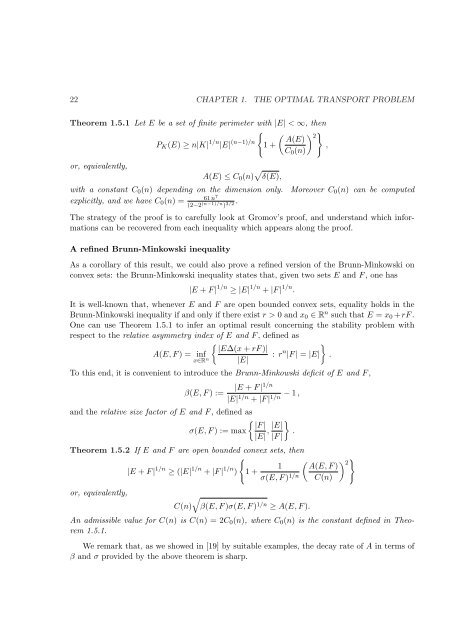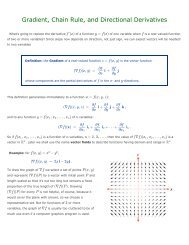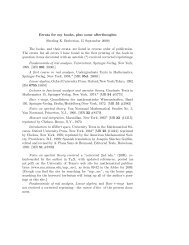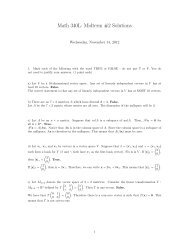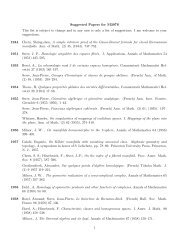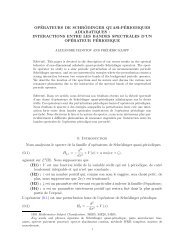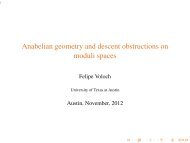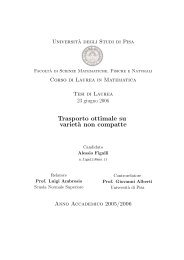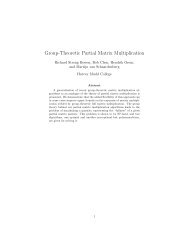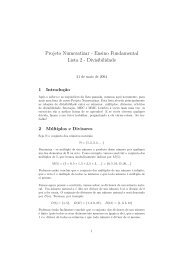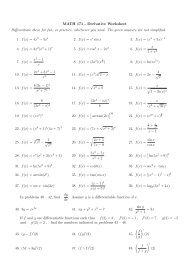Optimal transport, Euler equations, Mather and DiPerna-Lions theories
Optimal transport, Euler equations, Mather and DiPerna-Lions theories
Optimal transport, Euler equations, Mather and DiPerna-Lions theories
Create successful ePaper yourself
Turn your PDF publications into a flip-book with our unique Google optimized e-Paper software.
22 CHAPTER 1. THE OPTIMAL TRANSPORT PROBLEM<br />
Theorem 1.5.1 Let E be a set of finite perimeter with |E| < ∞, then<br />
PK(E) ≥ n|K| 1/n |E| (n−1)/n<br />
<br />
2<br />
A(E)<br />
1 +<br />
,<br />
C0(n)<br />
or, equivalently,<br />
A(E) ≤ C0(n) δ(E),<br />
with a constant C0(n) depending on the dimension only. Moreover C0(n) can be computed<br />
explicitly, <strong>and</strong> we have C0(n) =<br />
61 n 7<br />
(2−2 (n−1)/n ) 3/2 .<br />
The strategy of the proof is to carefully look at Gromov’s proof, <strong>and</strong> underst<strong>and</strong> which informations<br />
can be recovered from each inequality which appears along the proof.<br />
A refined Brunn-Minkowski inequality<br />
As a corollary of this result, we could also prove a refined version of the Brunn-Minkowski on<br />
convex sets: the Brunn-Minkowski inequality states that, given two sets E <strong>and</strong> F , one has<br />
|E + F | 1/n ≥ |E| 1/n + |F | 1/n .<br />
It is well-known that, whenever E <strong>and</strong> F are open bounded convex sets, equality holds in the<br />
Brunn-Minkowski inequality if <strong>and</strong> only if there exist r > 0 <strong>and</strong> x0 ∈ Rn such that E = x0 + rF .<br />
One can use Theorem 1.5.1 to infer an optimal result concerning the stability problem with<br />
respect to the relative asymmetry index of E <strong>and</strong> F , defined as<br />
A(E, F ) = inf<br />
x∈Rn <br />
|E∆(x + rF )|<br />
: r<br />
|E|<br />
n <br />
|F | = |E| .<br />
To this end, it is convenient to introduce the Brunn-Minkowski deficit of E <strong>and</strong> F ,<br />
β(E, F ) :=<br />
|E + F |1/n<br />
|E| 1/n − 1 ,<br />
+ |F | 1/n<br />
<strong>and</strong> the relative size factor of E <strong>and</strong> F , defined as<br />
<br />
|F | |E|<br />
σ(E, F ) := max , .<br />
|E| |F |<br />
Theorem 1.5.2 If E <strong>and</strong> F are open bounded convex sets, then<br />
|E + F | 1/n ≥ (|E| 1/n + |F | 1/n <br />
1<br />
) 1 +<br />
σ(E, F ) 1/n<br />
<br />
2<br />
A(E, F )<br />
C(n)<br />
or, equivalently,<br />
<br />
C(n) β(E, F )σ(E, F ) 1/n ≥ A(E, F ).<br />
An admissible value for C(n) is C(n) = 2C0(n), where C0(n) is the constant defined in Theorem<br />
1.5.1.<br />
We remark that, as we showed in [19] by suitable examples, the decay rate of A in terms of<br />
β <strong>and</strong> σ provided by the above theorem is sharp.


